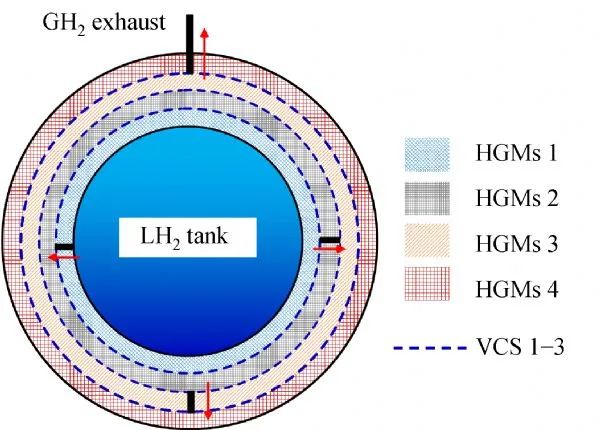|
|
|
|
|
FIE科研进展| 一种由玻璃微珠与自蒸发气冷屏组成的新型液氢贮箱复合被动绝热系统 |
|
|
论文标题:A novel cryogenic insulation system of hollow glass microspheres and self-evaporation vapor-cooled shield for liquid hydrogen storage (一种由玻璃微珠与自蒸发气冷屏组成的新型液氢贮箱复合被动绝热系统)
期刊:Frontiers in Energy
作者:Jianpeng ZHENG(郑建朋), Liubiao CHEN(陈六彪), Ping WANG(王平), Jingjie ZHANG(张敬杰), Junjie WANG(王俊杰), Yuan ZHOU(周远)
发表时间:
DOI:10.1007/s11708-019-0642-y
微信链接:点击此处阅读微信文章
液氢由于储能密度高而受到广泛关注。由于液氢沸点低(20 K),蒸发损失是其贮存过程中面临的一个突出问题,因而高效绝热技术是目前液氢贮存研究中的一个重要关注点。玻璃微珠由于表观热导率低,安装速度快(与多层材料相比,可以在短时间内注入)和维护简单等特点,成为一种有应用前景的绝热材料。本文提出一种由玻璃微珠和自蒸发气冷屏组成的新型低温绝热系统。建立了一个复合被动绝热模型对玻璃微珠和自蒸发气冷屏的耦合传热特性进行分析。结果表明,组合使用玻璃微珠和自蒸发气冷屏可以有效减少液氢贮箱的漏热。当冷屏数量从1个增加到3个,贮箱漏热分别减少了57.36%,65.29%和68.21%。玻璃微珠的另一个显著优点是其绝热性能对真空度的变化不敏感。当真空度从10−3 Pa升高到1 Pa时,贮箱漏热增加只有约20%。当真空度从10−3 Pa升高到100 Pa时,与单一使用玻璃微珠方式相比,组合使用玻璃微珠和冷屏的方式可以使漏热降低58.08%–69.84%。

Fig.1 Schematic of the proposed novel composite insulation system.
ABSTRACT
Liquid hydrogen (LH2) attracts widespread attention because of its highest energy storage density. However, evaporation loss is a serious problem in LH2 storage due to the low boiling point (20 K). Efficient insulation technology is an important issue in the study of LH2 storage. Hollow glass microspheres (HGMs) is a potential promising thermal insulation material because of its low apparent thermal conductivity, fast installation (Compared with multi-layer insulation, it can be injected in a short time.), and easy maintenance. A novel cryogenic insulation system consisting of HGMs and a self-evaporating vapor-cooled shield (VCS) is proposed for storage of LH2. A thermodynamic model has been established to analyze the coupled heat transfer characteristics of HGMs and VCS in the composite insulation system. The results show that the combination of HGMs and VCS can effectively reduce heat flux into the LH2 tank. With the increase of VCS number from 1 to 3, the minimum heat flux through HGMs decreases by 57.36%, 65.29%, and 68.21%, respectively. Another significant advantage of HGMs is that their thermal insulation properties are not sensitive to ambient vacuum change. When ambient vacuum rises from 10−3 Pa to 1 Pa, the heat flux into the LH2 tank increases by approximately 20%. When the vacuum rises from 10−3Pa to 100 Pa, the combination of VCS and HGMs reduces the heat flux into the tank by 58.08%–69.84% compared with pure HGMs.
Keywords liquid hydrogen storage(液氢贮存), hollow glass microspheres (HGMs)(玻璃微珠), self-evaporation vapor-cooled shield (VCS)(自蒸发气冷屏), thermodynamic optimization(热力学优化)
《前沿》系列英文学术期刊
由教育部主管、高等教育出版社主办的《前沿》(Frontiers)系列英文学术期刊,于2006年正式创刊,以网络版和印刷版向全球发行。系列期刊包括基础科学、
、工程技术和人文社会科学四个主题,是我国覆盖学科最广泛的英文学术期刊群,其中13种被SCI收录,其他也被A&HCI、Ei、MEDLINE或相应学科国际权威检索系统收录,具有一定的国际学术影响力。系列期刊采用在线优先出版方式,保证文章以最快速度发表。
高等教育出版社入选“中国科技期刊卓越行动计划”集群化项目。Frontier系列期刊中:13种被SCI收录;1种被A&HCI收录;6种被Ei收录;2种被MEDLINE收录;11种中国科技核心期刊;16种被CSCD收录。
中国学术前沿期刊网
http://journal.hep.com.cn

特别声明:本文转载仅仅是出于传播信息的需要,并不意味着代表本网站观点或证实其内容的真实性;如其他媒体、网站或个人从本网站转载使用,须保留本网站注明的“来源”,并自负版权等法律责任;作者如果不希望被转载或者联系转载稿费等事宜,请与我们接洽。